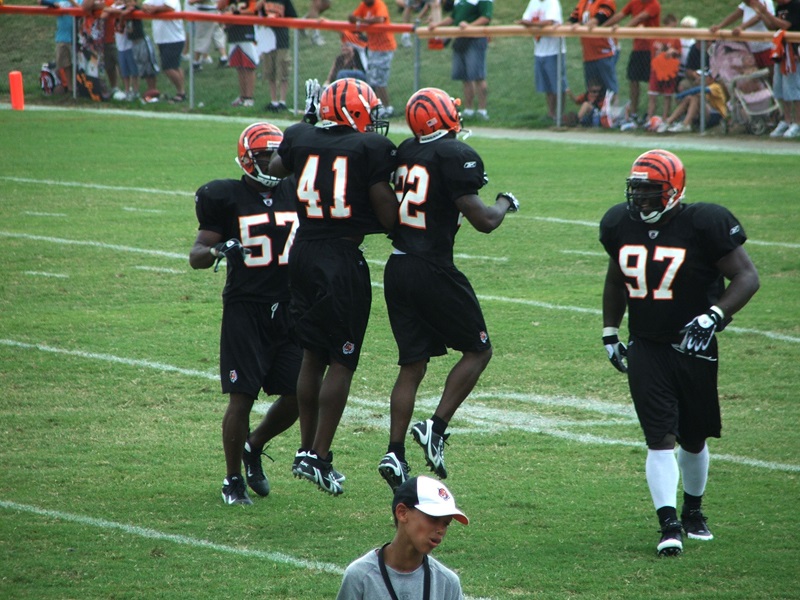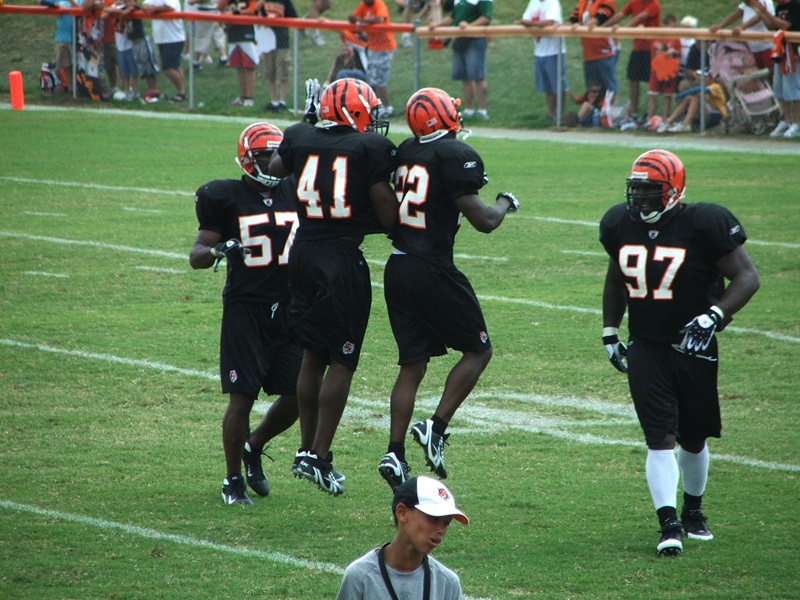
I’ve been a fan of Derrick Johnson since he was a destructive force for the Texas Longhorns. Watching the Chiefs beat the Browns this weekend, Johnson reminded me why I love watching good linebacker play. Among them is the act of taking on a lead block and dropping the ball carrier.
Here’s a variation of a trap play on 1st and 10 with 10:19 in the half with Cleveland on its five yard line. The play begins with the right tackle and right guard slanting to seal the line inside and block its way to the middle linebacker. The left guard pulls to seal the outside defender and the tight end on the wing – Jordan Cameron – is the lead blocker assigned to clear Derrick Johnson from the hole.
Good luck.
Johnson leans to the inside as he’s reading the line of scrimmage, spotting the pulling action of the guard and the tight end behind him. The right side of the Cleveland line does a good job of sealing the inside of the Kansas City front and you can see the right tackle working downhill towards the middle linebacker. If the Browns can block Johnson and the outside linebacker Justin Houston on the edge, this play will yield a nice gain.
As you can see below, the pulling guard takes a strong angle to Houston and keeps the outside linebacker wide of the running lane. The right tackle reaches the middle linebacker at the second level and the interior lineman are all sealed inside as the Brown’ runner follows Cameron into the hole.
Johnson slides to the hole with his pads square to the running back. Note to the fullback coming from the right side near the “1st & 10” graphic of the television broadcast. Johnson has a small margin of error on this play. If he begins with an angle too far outside, he could get double-teamed by the tight end and fullback and the runner earns a lane inside those blocks. If the right tackle can sustain his block for another second, the back is off to the races. If Johnson is too far inside, the tight end can try to pin the linebacker into the line of scrimmage to create an even larger running lane.
This is my favorite part of the play. Johnson takes an outside angle and essentially dips into a three-point stance to slip under Cameron’s block. The conceptual thinking for Johnson here is that if he forces the runner inside, there’s a greater chance that one of his teammates will come free and make the play on the runner if he doesn’t. The physical technique to go from an upright position and almost leaning backwards to this three-point stance in less than a second is the beauty of top-notch defensive athleticism. It’s also a great understanding of angles.
On the other hand, the runner takes a long step towards Johnson when sees the linebacker shooting for him. This is an attempt to put on the breaks and change direction, but the long step prevents him from maintaining his footing. It’s hard to say whether shorter steps to the hole could have altered the outcome of this play. However, I do wonder about the runner’s approach. Based on the angle of his pads and hips, he appears as if he’s still uncertain which direction to take.
What I wish I knew for certain is the fullback’s assignment. It seemed like the fullback had a great opportunity to double-team Johnson. At the same time, it appears the fullback also has an eye on assisting the right tackle on the middle linebacker. If Cameron can take care of Johnson, then it’s the fullback’s help on the middle linebacker that will open this whole beyond the second level of the defense. Forced to guess, I’ll say that the expectation was for Cameron to beat Johnson one-on-one, which proves to be a tough assignment for a young tight end who has earned his place in the starting lineup for his pass receiving more than his run blocking.
Johnson shoots past the runner’s legs the same way Bruce Lee used to emphasize punching past the target point to ensure there’s power behind that blow. Also note that Johnson’s hit is at knee-level. Even a runner with tremendous feet will have difficulty avoiding Johnson’s angle.
Johnson gets under Cameron and shoots through the runner’s legs, upending the ball carrier. The back manages to fall forward to the line of scrimmage, but Johnson foils a play that if he handles wrong should have been at least a four-yard gain and at best a run of 30-40 yards.
For more analysis of offensive skill players download the 2013 Rookie Scouting Portfolio available April 1. Prepayment is available now. Better yet, if you’re a fantasy owner the 56-page Post-Draft Add-on comes with the 2013 RSP at no additional charge. Best, yet, 10 percent of every sale is donated to Darkness to Light to combat sexual abuse. You can purchase past editions of the Rookie Scouting Portfolio for just $9.95 apiece.
























